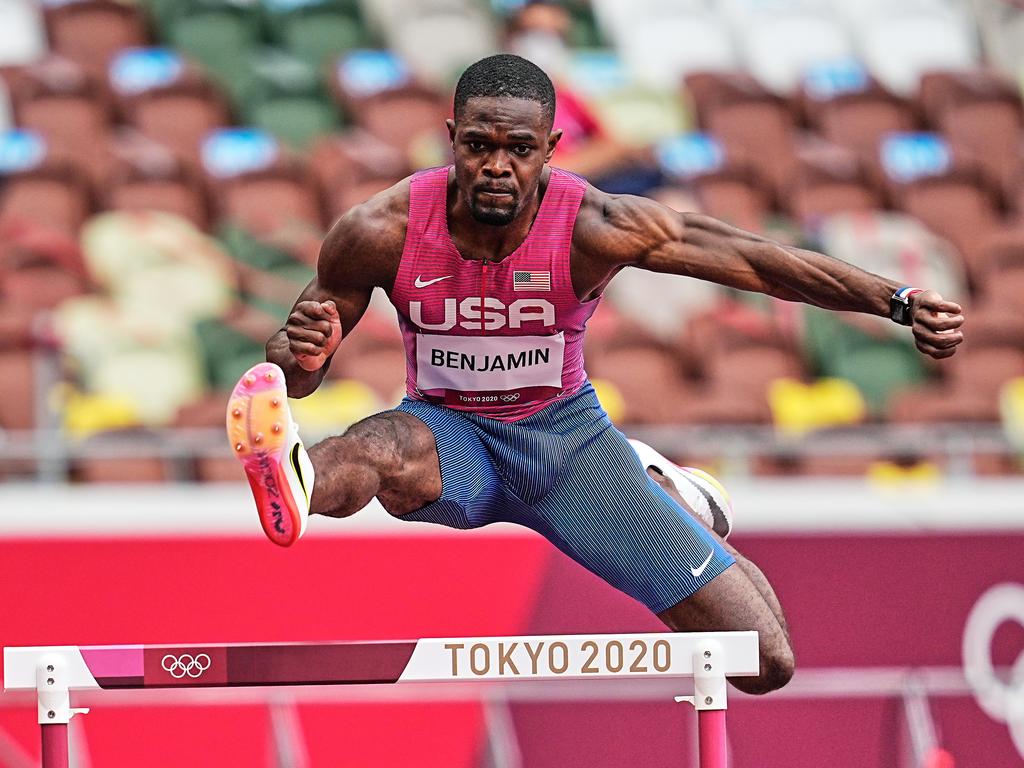Uproar over ‘bulls***’ Olympic super shoe as world records continue to fall
We’ve seen some blistering runs in Tokyo but there’s more to these freakish performances than good old-fashioned leg speed.

Karsten Warholm’s incredible gold medal performance in the men’s 400m hurdles was hailed as the greatest race of all time but it’s resulted in plenty of questions being asked about what’s going on in Tokyo and athletics in general.
Warholm became the first person to run sub-46 seconds in the event as he obliterated his previous world record. But is there more than meets the eye to the latest in a string of record-breaking times we’ve seen this year?
For many, the answer is an obvious yes. So how are runners going so fast, breaking barriers previously thought unbreakable? Well, apart from the obvious – freakish athletic talent – lie two major factors: Their shoes and the track.
‘Super shoes’ back in the spotlight
After Warholm’s jaw-dropping win English sports writer Matt Lawton tweeted: “Warholm is an amazing athlete but I think we’ve just seen the impact of technology right there. The shoes and a track that is apparently like running on air.”
“Super shoes” have become the norm in athletics. Nike’s controversial hi-tech Vaporfly was worn by Eliud Kipchoge when he ran the first sub-two hour marathon in 2019 and created plenty of controversy over whether it was compromising the integrity of running by giving runners too much of an artificial boost.
The shoe was later cleared, though not without warnings about blurring the line between human achievement and technological assistance.

Used predominantly in long-distance road running to start with, the technology has graduated to shorter distances on the track, which is why it’s a talking point at these Olympics. The shoes are loaded with carbon plates that act like a spring, while some spiked shoes now contain air pods that also provide extra bounce.
BBC sports editor Dan Roan recalled taking a pair of super shoes to be examined by a university in Manchester a few years ago.
“They’re very thick soled, highly stacked and they have patented foam in them, and they have carbon plates in them too which gives these shoes a certain rigidity,” Roan told The Sports Desk podcast this week.
“You could actually see this hidden carbon plate which runs the length of the shoe, and this very high heel and the experts there were telling me that what it basically does is return a lot of the energy you would usually lose when you run back to the runner. It doesn’t just escape, it returns it to you and makes it a very efficient form of running.”
‘Off the scale’: Why all the fuss?
Nike pioneered the pursuit of the super shoe and was way ahead of the game, but the postponement of the Olympics by 12 months helped competitors catch up and develop their own technology.
Letesenbet Gidey of Ethiopia was wearing super shoes when she broke the women’s 10,000m world record in June and Ugandan Joshua Cheptegei used the shoes to set the men’s 5000m world record of 12:35.36 last year. He also crushed the 10,000m world record last October, posting a time of 26 minutes, 11 seconds — obliterating the old mark by more than six seconds.
Speaking on The Sports Desk podcast, Lawton called the achievement “off the scale in terms of human performance, human achievement” and “incomprehensible even 15-20 years ago”.

Looking ahead to the track action in Tokyo Lawton said crazy times weren’t neceesarily the issue, but making sure everyone competed on the same level was. Athletes without super shoes know they risk being left behind — and it’s not a risk they’re prepared to take.
“The other shoe companies were miles behind (Nike) and actually had it not been for the delay to this Olympic Games, would have been miles behind here in Tokyo,” he said. “It would have been an absolute disaster for the athletes that weren’t sponsored by Nike.
“Prior to Olympic trials, British athletes I was aware of were actually tearing up contracts or not accepting contract offers because they knew the only chance they had to get to Tokyo was to have one of these pairs of shoes on, because their sponsors weren’t producing the right spike.
“The bigger issue with this technology for Tokyo is not about records, I don’t think, it’s about a level playing field.”
Why are we talking about super shoes again?
Warholm helped put super shoes back on the agenda after his mind-blowing win. The Norwegian’s Puma shoes were developed in conjunction with F1 powerhouse Mercedes, but after shattering the world record he defended his footwear.
“What I can say about the shoes that I’ve been developing in a collaboration between Puma and the Mercedes Formula One team is that we’re trying to make it as credible as it can be,” Warholm said.
“Yes, we have the carbon plate but we have tried to make it as thin as possible because that’s the way that I would like to do it.
“Of course, technology will always be there but I also want to keep it down to a level where we can actually compare results. That’s important.”
But Warholm wasn’t so impressed with the Nikes of 400m hurdles silver medallist, Rai Benjamin.

“In middle distance I can understand it because of the cushioning. If you want cushioning, you can put a mattress there,’ Warholm said. “But if you put a trampoline there (in the shoe) I think it’s bulls**t, and I think it takes credibility away from our sport.
“I don’t see why you should put anything beneath a sprinting shoe.”
Benjamin — who broke the previous world record with his run on Tuesday only to be outshone by Warholm in the same race — doesn’t see the problem, saying while the shoes help they’re not the biggest factor.
“I’ll wear different shoes and still run fast. It doesn’t really matter, in all honesty, at the end of it,” said the American.
“I mean, there’s some efficiency in the shoe, don’t get me wrong, and it’s nice to have a good track but no one in history is going to go out there and do what we just did just now, ever.”
‘Trampoline’ track is fast as lightning
Warholm’s blistering performance wasn’t the only rapid run we’ve seen in Japan. In fact, seven of the eight runners in that 400m hurdles final crossed the line in personal bests. Sydney McLaughlin than saluted in world record time in the women’s 400m hurdles.
Italian Marcell Lamont Jacobs came from the clouds to win the men’s 100m in 9.8 seconds, while the women’s 100m final was seriously quick as six runners cracked 11 seconds. Elaine Thompson-Herah broke a 33-year-old Olympic record to win in 10.61 seconds while Shelly-Ann Fraser-Pryce, at 34, managed to claim silver in 10.74s.
So what role is the track playing in all of this?
Made by Mondo, the surface has been described by runners as one of the quickest they’ve ever seen, putting a huge spring in their step — literally.
AP reports the manufacturer says its specially-designed track features “three-dimensional rubber granules specifically designed with a selected polymeric system that are integrated in the top layer of MONDOTRACK WS that are added to the semi-vulcanised compound. The vulcanisation process guarantees the molecular bond between the granules and the surrounding matter, creating a compact layer”.

Forget the jargon — what that means is it’s bloody fast and the athletes know it. American 100m specialist Ronnie Baker said he felt like he was “walking on clouds” and fellow sprinter, Akani Simbine of South Africa, added: “You just feel it, man, you just feel it. You know what fast tracks feel like. And for us, this track feels really quick.”
Winner of the women’s 400m final, Sydney McLaughlin, said: “Some tracks absorb your motion and your force. This one regenerates it and gives it back to you. You can definitely feel it.”
Warholm joined in too, calling the track “crazy”.
The New York Times reports Mondo spent three years preparing its track for Tokyo, constantly fine-tuning until it came up with the perfect recipe.
International manager for Mondo, Andrea Vallauri, said “we had a special ambition to come up with something different”. They certainly did just that.
After receiving feedback from athletes, The Times reports “designers … experimented with different types of rubber before incorporating three-dimensional granules in their final design. The surface that resulted, according to Vallauri, allows shock absorption and energy return ‘like a trampoline’”.
It’s that same “trampoline” that helped a shocked Yulimar Rojas destroy the world triple jump record, making her mark at 15.67m to better a distance that had stood as the benchmark since 1995.
Based on what we’ve seen so far, even more athletes will bounce their way to personal bests before the Games are over.




